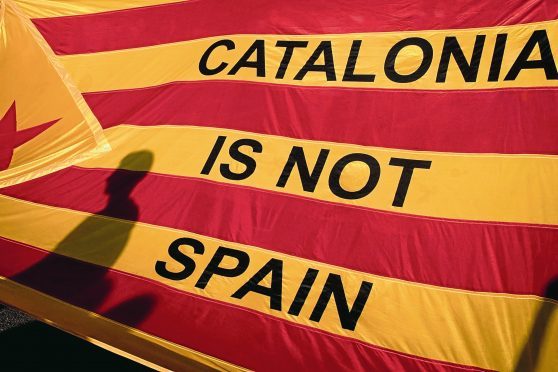Did the Spanish government give any thought to the history of nationalism when they sent police to beat up Catalan voters last Sunday?
It’s never the cause alone that wins but the oppressive violence which tries to stop it. Every baton that fell on to the flesh of Spanish citizens in Barcelona was a recruitment agent for Catalan independence. What seemed far off a week ago is now very real because of a foolish decision to strong-arm people out of voting.
The Catalan leader, Carles Puigdemont, is suggesting Catalonia could declare “independence” this Sunday, just as the SNP gather in Glasgow for their conference.
Scot Nats will rejoice at the success of their Cat Nat colleagues – even though this “independence” is far from assured, defined or even wanted by many Catalonians.
Yet again, supporters of Scottish independence will wonder what it takes for them to join the ranks of nationalist movements which have won a majority. Scots did, after all, set the example by which much of the world now follows.
Since the 2014 referendum, British nationalists have triumphed in the Brexit vote, and American ‘white’ nationalists were successful in electing Donald Trump.
Catalonia’s nationalism was driven forward by Scotland’s referendum, and identity parties across Europe have become stronger. All these movements are not the same – some are far right, some incoherent, some just the rage of apparently forgotten men – but we can reasonably connect them all as protests against an establishment and invoking and old identity as a defence against the future.
So why, having inspired the trend for nationalism, is Scotland still firmly in the union? Scottish nationalism fails politically on two counts. Its own story isn’t thorough enough, and Scotland isn’t oppressed.
Unionists accept Scotland is a nation and spent much of the 2014 campaign saying Scotland could survive on its own. Thus, the basic, instinctive driver of nationalism is defused with casual acceptance. That doesn’t stop many a Nat claiming they are denied national recognition but this exists only in their imaginations.
The brigade of ‘too wee, too poor’ takes comfort from repeating that imagined insult, but it is a slur never uttered by unionist.
Instead, the case against Scottish nationalism focuses on three weaknesses in the Nats’ story. The first is the absence of a notional first-year budget for an independent Scotland.
Religiously, the SNP have continued a Tory policy of producing figures (the Government Expenditure and Review Scotland or GERS), which show Scottish spending within the UK, though this is rarely positive for their cause. Yet never have the SNP set up their own annual exercise showing how Scottish spending would look under independence. This is cowardice – the SNP leaders do not want to engage seriously on the choices facing Scotland.
A notional budget exercise would tease out all the matters over pensions, debt and growth that are essential to any serious approach to independence.
In not doing this, the SNP in government have betrayed the nationalist movement, treating it as a child to be grateful for a pat on the head, not an adult wanting a serious debate.
The second flaw in the SNP story surrounds the costs over independence. It is 1,441 days since the Scottish Government published its white paper on independence, based on figures which ranged from optimistic to deceitful. I base that observation on conversations with key people involved in drawing up the white paper – it is the view of people in the room at the time. Since then, not a word further on any policy aspect of how independence would be achieved or managed.
This despite every assumption made in 2013 – the year of the white paper – having been rubbished by reality. It means we don’t have any further information on the other key question: what currency are we using.
I raised all these matters more than two year ago to howls of ‘traitor’ and accusations I was a unionist stooge – the internet fizzed with claims I was seeking a peerage.
Since then, every word I wrote has been proved right and no extra information has been provided – oh, and Alex Salmond has been punted as an ideal member of the House of Lords.
The SNP conference delegates will condemn the Tories, mock Labour’s in-fighting, pompously declare that Jeremy Corbyn isn’t right for Scotland, recite a long list of achievements which add up to no more than everyday government, try to take some credit for Catalonia, come up with a gimmick on waiting times in the NHS, take a swipe at the mainstream media, iron their underwear and go home happier but none the wiser.
Scotland’s bid for independence will be serious when Scottish nationalists are serious about themselves. That requires serious discussion on what’s available to spend, what legacy costs will remain with the UK and how much state debt is sensible.
The SNP strategy is to hope some metaphoric baton lands on Scotland and outrage will carry the country to independence. So it is that SNP stooges have become a major obstacle to Scottish independence, cowards waiting for someone else to take responsibility for their cause. Real nationalists need to do the work the government and party won’t.
